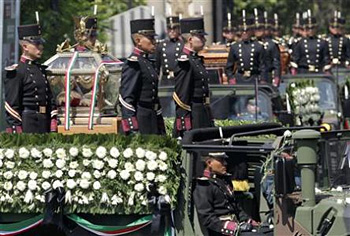
|  |  |  News Around the Republic of Mexico News Around the Republic of Mexico  
Mexico Heroes' Bones Paraded
 Leslie Josephs - Reuters Leslie Josephs - Reuters
go to original
May 31, 2010


| | Cadets guard a crypt during a homage at Chapultepec Castle in Mexico City, May 30, 2010. (Reuters/Daniel Aguilar) |  |
Mexico City - Mexican soldiers on Sunday paraded the bones of the heroes of the country's Independence War down the capital's most famous street before scientists begin trying to solve a century-old mystery by identifying the bones.

"Thanks to them, Mexico exists," President Felipe Calderon said at a ceremony involving hundreds of soldiers, a 100-piece military band and watched by thousands of Mexicans.

Army cadets dressed in formal 19th-century style uniforms gingerly carried out the glass urns containing the remains of leaders of the war against Spain from the base of the towering Angel of Independence monument. The bones were then escorted down Paseo de la Reforma, accompanied by dozens of black horses with banded manes.

"They're the ones who represent independence to the Mexicans," Elias David Figueroa, 56, who sells handicrafts in Mexico City, said after tossing two white carnations toward the urns as they moved down the avenue. "It makes us proud to see them."

The remains of 12 fighters -- including Miguel Hidalgo, a priest whose "Cry of Dolores" call to arms touched off the independence struggle -- had been scattered across the country after the war against Spain ended in 1821. The government ordered the leaders' bones be reburied in poorly constructed tombs in Mexico City's giant Metropolitan Cathedral in 1823.

Dug up at the turn of the 20th century after complaints about the state of the tombs, the bones were placed in new urns but many were jumbled together.

Following Mexico's 1910-20 revolution, the urns were moved to the towering Angel of Independence after revolutionary leaders broke with the Catholic church.

The skulls of Hidalgo and three other major figures in the war are identified but doubts have circulated since the turn of the century about the rest of the remains.

Some historians suspect they may even include those of the last Spanish viceroy of New Spain.

The effort to identify the remains is part of Mexico's preparations for the bicentennial of its independence from Spain, which will be celebrated later this year.

Specialists from Mexico's National Institute of Anthropology and History plan to compare the bones with historical records of the heroes' heights and injuries so they can determine which bones belong to which hero.

The government plans to exhibit the remains starting in August before returning the bones to the Angel of Independence monument in August 2011.

A dozen protesters jeered Calderon's speech, calling him a lapdog of Washington and blaming him for Mexico's troubled economy and mounting drug gang violence, which has killed 23,000 people since he took office in 2006.

"Those are our heroes," Juan Francisco Vergara, a 23-year-old political science student said angrily. "He's just trying to look good. It's the only thing he can do."

(Editing by Robert Campbell and Bill Trott)
|

 |
|  |



